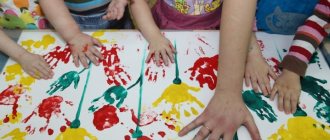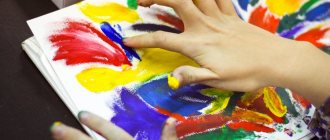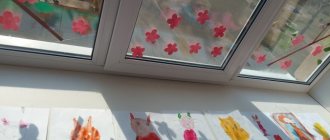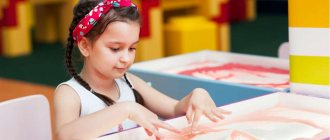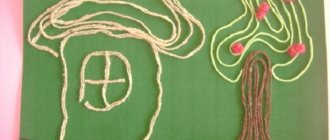Unconventional drawing in the second junior group
An unconventional way of drawing is, first of all, artistic effectiveness and unpredictability of the result. The technique includes unusual techniques for performing work that do not require special skills. This option can be reminiscent of an exciting activity that will allow kids to unleash their creative potential in a minimum amount of time. This method offers budding artists creative freedom.
An unconventional drawing method for younger children
For example, if a child smears his finger in paint and draws with it, or leaves his palm print on the drawing, the teacher will not punish him. The process is completed only by adding elements to obtain the desired result. Drawing turns into real fun.
What does the use of non-traditional techniques give to students?
Even at an early age, children want to reflect their impressions and explore the world around them through visual activities. Visualization of sensations helps them with this. Therefore, the child strives to make a drawing with one finger on the foggy glass.
Note! Some kids need a stick to draw pictures in the sand or chalk for the asphalt.
Existing non-traditional drawing techniques in kindergarten in the 2nd or 3rd junior group according to the Federal State Educational Standards method, which allow you to quickly see the results of your activities. This technique greatly simplifies the process when solving some teacher problems in methodological terms. Presentation of the drawing contributes to:
- development of creative abilities;
- formation of a non-trivial view of the world around us;
- nurturing independence.
The importance of classes
Even at 3 years old, children find it difficult to hold a brush in their hands. Not everyone is equally interested in visual arts. Therefore, in order to present your child with artistic creativity in all its glory, it is necessary to choose an appropriate theme. The drawing process must be turned into exciting entertainment. Teachers recommend conducting various experiments, for example, using unusual materials (leaves, sand, salt).
The use of alternative non-traditional drawing techniques for children aged 3-4 years has the following meaning:
- Full mental development of the child, increasing self-esteem, overcoming all fears.
- Development of abstract thinking.
- Formation of a holistic perception of the subject.
- Creating all kinds of conditions so that the baby can reveal his creative potential and freely express his individuality.
- Introducing children to the properties of various materials.
- Development of tactile sensations.
What techniques are used
Modern methodology contributes to the implementation of the educational task when performing work.
Note! A similar technique is considered for children from 3 to 4 years old. In addition, you can organize additional interesting activities with minimal financial costs.
What technique is used in practice?
Drawing with cotton swabs
An unusual drawing technique develops a sense of rhythm and color. Cotton swab (stick) - a popular drawing technique is called the “poking method”. When creating a drawing, it is impossible to do without a cotton swab, container, and wet wipes. When creating a new material, little artists place a stick in a container of paint, and then apply imprints to the drawing.
Environmental education of preschool children
Important! Young artists can depict a river, rainbow, grass, rain, snow, sun, tree, sky or something else.
When creating a drawing using a cotton swab on the theme “Trees when autumn comes,” the teacher must show the children how to properly hold this object in their hands.
Instructions: Children receive blanks of tree trunks with branches, cotton swabs, and paints.
Important! To make it easier for the children, you can mark the area of the drawing, indicating the exact location of the foliage.
Finger painting
To implement this method, you can do without certain material. For example, a teacher prepares paint in advance with wet wipes.
Note! Implementing teamwork based on this technique is a great idea for both educators and preschoolers.
The teacher takes into account the mental and physical characteristics of the children and prepares a topic for drawing in advance, for example, “Foliage of autumn trees.” The teacher provides the little artists with a template - a large tree.
Other themes are also covered, such as “Winter” or “Summer is Coming.” In kindergartens, the finger painting “Snowflake” is most often created. To perform it, paints and pencils are used.
Instructions: The teacher distributes A4 sheets. The guys must draw a snowflake. To complete the work you will need a blue and white pencil.
Drawing with palms
This method is not the most accurate, since children must draw with their palms. Before creating a drawing, the teacher must prepare a shallow container of paint. Pour some water inside and drip some gouache.
Note! Using this method, you can easily create collective drawings, for example, “Fish in the Aquarium”, “Our Aquarium”, “Merry Matryoshka”, “Firebird”, “Winter has come”.
Instructions: The teacher shows the children the finished substrate. The drawing is created on a sheet with a blue background. The guys must completely dip their palm into the container of paint. Then the teacher calls on the kids to go to the table where the aquarium is located, stand in a circle and leave their imprint there with their thumb up or to the side.
There is no need to put a mark on the one that the first comrade has already put. The teacher also warns that the fish must be located at a certain distance from each other. Then make an eye for your fish using white paint. Dip your index finger into black paint, make a pupil and carefully draw a line near the mouth.
Drawing with soap bubbles
This technique is the most difficult. Here children will have to show their imagination (open mind). Before starting to draw with soap bubbles using the preschool method, the teacher prepares material in the form of liquid soap, baby shampoo, water, watercolors (food coloring), cocktail tubes, and spoons.
Drawing lesson on the topic “Beautiful Flowers” in senior groups
Initially, the teacher prepares the mixture, and then pours the mixture equally into small glasses. You can prepare the paint by diluting soap with water (the ratio should be 10:1). After obtaining the mass, the addition of dye and a little gelatin or glycerin is required. Thanks to these components, the bubbles retain their shape for a long time. The finished mixture will have to be placed in a cool place (away from the sun) and kept for 2 days.
Important! It is recommended to strain the mass through cheesecloth. The finished mixture should be placed in the refrigerator for 10 hours. Having received the material, you can make a outlined and regular print.
Instructions: The teacher invites the children to take a sheet of paper, a container with soap solution, straws and disposable teaspoons. Children must blow into the tubes to create foam. Next, a mass of one color is collected and laid out on a sheet. The balls should be placed far from each other. Once the shape of each print is dry, children can add a string to each ball.
Drawing with stamps
Drawing with stamps can reveal the possibilities of using familiar objects as art material. This method promotes the mental development of the child.
Note! When drawing with a stamp, a child develops an interest in inventive art, which leads to increased self-esteem and the development of coordination of movements.
Foam rubber impression
The main goal of this method is to introduce students to an unconventional method of drawing using the “foam rubber imprint” technique, and to develop the ability to arrange the elements of a drawing on a sheet of paper.
Educational qualities: fosters a love of fine arts and nature.
Developmental qualities: to develop aesthetic perception, a creative attitude to work, attention, memory, spatial thinking, fine motor skills of the hands, a sense of composition, color, color perception, to form in children a stable interest in visual arts, creative imagination.
Scheme for drawing up lesson notes
This work must begin with the formulation of goals and objectives through visual activity. As for the goals, to those that were identified in the context of non-traditional drawing techniques in general, we can add some specific ones:
- practice the ability to recognize and name colors;
- introduce children to different types of drawing materials (gouache, watercolor, etc.);
- cultivate accuracy and goodwill in group and individual work.
During drawing classes using non-traditional techniques, the following educational tasks are solved:
- children learn to work with signets, soap bubbles, cotton swabs, and also learn to draw with their fingers or palms;
- an idea of paint concentration and basic skills in creating shades are formed;
- expressive images are created, while maintaining the liveliness and spontaneity of the child’s worldview;
- the joy of receiving a product of one’s own creativity is fostered.
The success of the lesson also depends on how carefully the teacher distributes time between all stages of work. As you know, a lesson in kindergarten lasts 30 minutes, during which you need to go through 3 stages of work:
- introduction (about 5 minutes) – implementation of motivational techniques (conversation on a topic, playing with visuals, role-playing, reading poems, listening to songs, etc.);
- the main part (about 20 minutes) is to complete the drawing;
- conclusion (about 5 minutes) - summing up, praise of the teacher, reflection of the kids (in the form of answers to questions - “Did you like drawing in such an unusual way?”, “Do you think you succeeded?”, “Whose work do you think is the most beautiful ? etc.).
Whatever technique you choose, children must be helped to realize their intended image.
Please note that some techniques (such as signet painting) do not require much time to complete. In this case, you can increase the timing of the introductory part using dramatization, role-playing, that is, techniques that require a lot of time.
An example of a lesson plan on non-traditional drawing in a junior group
Summary of a drawing lesson using non-traditional techniques in the first junior group: “Flowers of unprecedented beauty.” The plan for this outline is drawn up by the teacher. Young artists are introduced to a new technique of unconventional drawing - “Painting with a palm and a sponge”.
An example of a note on drawing using non-traditional techniques
The teacher says that when spring comes, all nature wakes up after winter. During this period, all trees and shrubs begin to turn green. The very first spring holiday is Mothers' and Grandmothers' Day. Next, the children are shown illustrations of flowers. In addition, the teacher teaches how to convey the image of flowers, structure and shape using a sponge.
The project is aimed at developing creative imagination in children of primary preschool age through the use of non-traditional drawing techniques. These techniques allow the child to express with interest his impressions of the world around him in his drawings. An unconventional approach to making images is self-education and the development of children's intellect; it encourages the child's creative activity and teaches him to think outside the box.
Technique for drawing with cotton swabs
Each visual technique has nuances that you need to know in order for the drawing to turn out beautiful and correct. This also applies to pointillism.
Which non-traditional techniques for drawing with cotton swabs to choose depends on the age of the kindergarteners. Children 1-3 years old either draw in one color according to templates, or make the finishing touches on a full-fledged drawing with dots. Children 3-5 years old draw using patterns using several colors. And preschoolers aged 5-7 years will certainly be able to create a complex multi-color painting using the pointillism technique.
Before the main stage of the lesson, conduct an introductory conversation. Tell your students in simple words about pointillism, demonstrate the works of famous artists who worked in this technique. To interest children, explain that the pictures in question are created by applying many colorful dots.
In the younger group
For very young pupils, prepare primitive templates, the coloring of which requires one color: orange (orange), sun (yellow), leaf (green), rain (blue). In addition to templates, kids can be asked to complete a full-fledged drawing: complete the eyes of an animal, make petals for a flower, snowflakes falling on a Christmas tree, or berries on a rowan branch.
Children 1-3 years old draw more dexterously with a stick than with a brush. First, show your student how to correctly place spots and strokes of different colors. Kids usually quickly understand the technique because they used to draw with their fingers in the same way.
For drawing with cotton swabs in the younger group, first come up with a theme, select appropriate riddles and poems to arouse the child’s interest. In the middle of the lesson, be sure to do finger exercises in a playful way: it will help your child not get bored.
In the middle group
For preschoolers 3-5 years old, prepare more complex contour templates that require several colors to draw. The best option is coloring books depicting animals, fish, toys.
Do not choose overly complex images containing more than 5 colors. Otherwise, the child will get confused in the palette.
To diversify drawing with cotton swabs in the middle group, you can invite children to fill the template with colored spots not completely, but only to outline the outline. And make the fill regular, watercolor.
In the older group
Children 5-7 years old do not need templates; they can independently draw an image with a pencil and fill it with spots of suitable colors. Explain to the students that they first need to draw an outline, then fill in the middle of the drawing. At an older age, kindergarteners should use several colors.
For drawing with cotton swabs in the older group, you can use two interesting techniques:
- Short strokes. The stick should not be pressed against the paper sheet, but light and short strokes should be made. In this case, the strokes can be placed side by side, slightly overlapping each other. This is how the drawing acquires an interesting texture. The method is optimal for drawing animals, birds, trees, and ponds. The creation of living beings begins with the eyes, then the strokes in the correct order go along the body. When painting landscapes, the strokes are chaotic, superimposed on each other.
- Cotton bundle. If you connect several cosmetic sticks and secure them with tape or rubber band, you can depict multiple small details: berry bunches, the crown of trees and shrubs, a flowering meadow, a starry sky. How many copies to use depends on the desired frequency of spots in the pattern. You can fasten the sticks in a row, then you can depict a fence, a bench, beds, a rainbow.
In the preparatory group
Children of older kindergarten age are already able to independently create full-fledged pictures from dots, using any number of colors. Once preschoolers have mastered pointillism, you can encourage them to make a drawing using several of the visual techniques they have learned.
Make drawing with cotton swabs more difficult in the preparatory group: use mosaics. Have children assemble a picture from the parts, then draw it on paper, referring to the original picture.

